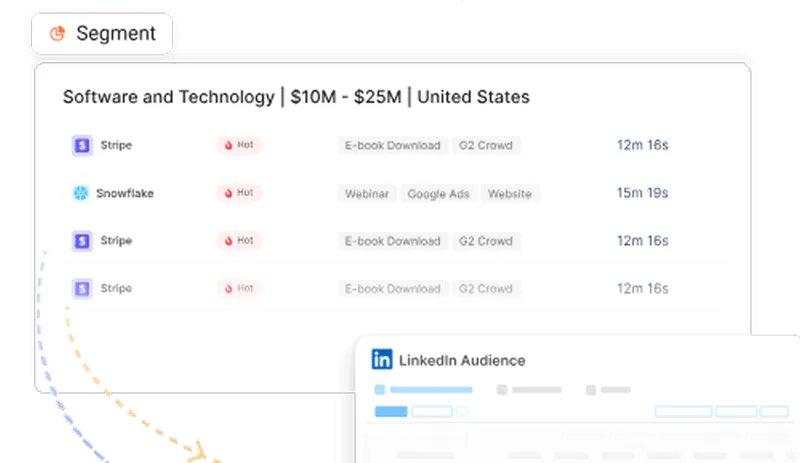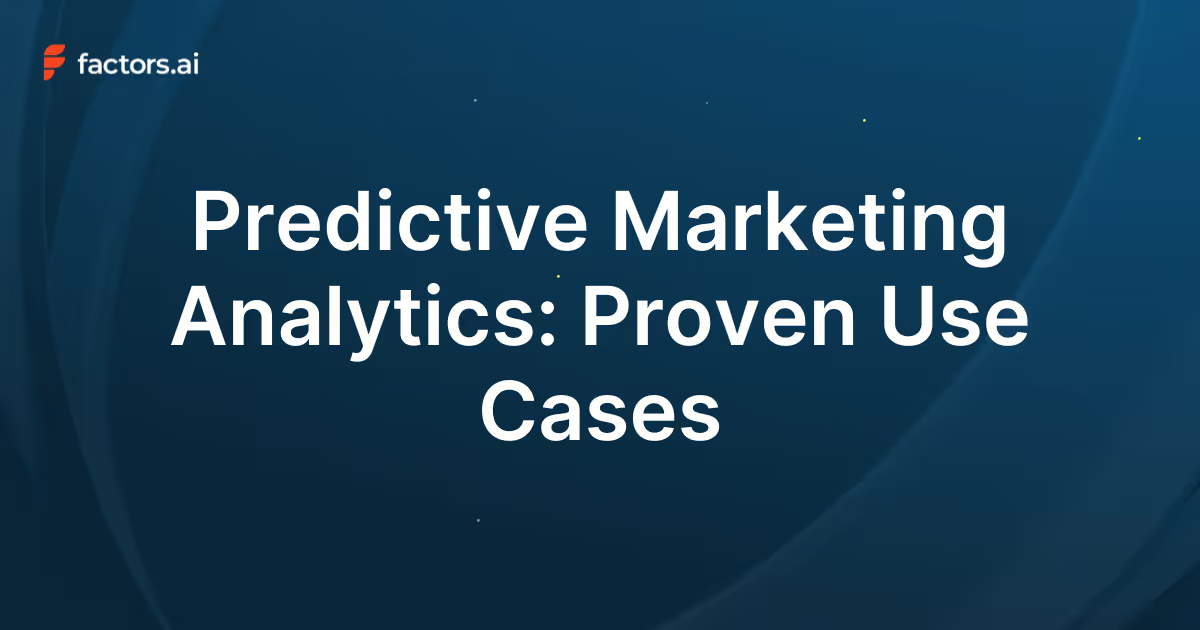Time Decay Attribution Model Explained
Discover how Time Decay Attribution can help marketers understand the true impact of their marketing efforts. Learn its benefits and drawbacks here.
You’ve tested your product to market fit and you’re seeing an amazing response to your solution across the board.
But you're not growing at the pace you’d like. Maybe you’re unable to reach your target audience, maybe your ad campaigns aren’t working as expected, maybe your website isn’t up to par, or maybe sales reps are dropping the ball.
It’s overwhelming. To sort through multiple marketing and sales channels, to pinpoint where the problem is and allocate spends efficiently.
Out of all the marketing attribution models, time-decay attribution proves to be one of the most effective models when facing the challenges of business growth.
What is Time Decay Attribution?
The time decay attribution model assigns credit to customer touchpoints across the marketing and sales funnel based on their temporal proximity to a conversion goal. It recognizes that interactions closer to the conversion point have the most significant impact. Accordingly, it gradually diminishes the credit assigned to earlier touchpoints.

Picture a company trying to understand how customers decide to sign up for their product. Along the customer's journey, buyers first see an ad on a tech blog a few months ago. Then, they attend a webinar, and finally, they receive a targeted mail, prompting them to convert.
Using a time decay attribution model, the email they received just before the conversion gets the most credit (50%) because it had the most immediate impact. The webinar would recieve some credit (30%), and the initial ad (20%) would receive the least credit.
This model recognizes that while all interactions play a role, their influence varies over the customer journey from the first touch to conversion. It helps companies see which touch points were most influential, allowing them to fine-tune their marketing strategy accordingly.
Why The Time Decay Attribution Model Matters
A variety of attribution models exist, including First Interaction, Last Interaction, Linear, Position-based, and Time Decay. Each has their own benefits and limitations based on the nature of your business.
Generally, the last click model has been the most popular but it can be heavily limiting as it’s a single-touch model that attributes conversions solely to the last touchpoint. As you might expect, this doesn't account for the contribution of previous touchpoints that led to the conversion. While this might be suitable for most B2C brands looking to see what channels drive the most conversions, it fails to capture the complexity of a lengthy, non-linear B2B sales cycle.
Let’s take a multi-touch model: linear attribution. This model assigns equal credit to all traffic sources, treating them uniformly, but it might not fully reflect reality. Each channel impacts decision-making differently, and giving them equal credit might be a limiting view for companies looking to optimize their marketing efforts and shorten their sales cycle.
Here’s where time decay attribution models fit in. Time decay attribution strikes a balance between giving credit to all relevant traffic sources in reverse order, and how each channel contributed to the decision-making process.
Benefits of Time Decay Attribution
Much like other attribution models, the time decay model has its unique benefits and limitations. Here are a few things to consider before you implement a time decay attribution model.
1. True-to-Life B2B Attribution
In reality, each GTM channel has a unique life cycle, leading to natural performance fluctuations over time. Identifying these changes promptly represents a significant chance for enhancing results, and Time Decay offers a means to seize this opportunity.
This is because Time Decay assigns greater weight to the most recent touchpoints, it amplifies the influence of significant performance fluctuations within those sources on the overall outcomes. Consequently, the utilization of Time Decay empowers a more reliable method for determining the priority of pipeline sources that require immediate attention and improvement compared to other attribution models.
2. Best for Conversion Optimization
The Time decay attribution model's benefit lies in its capacity to enable you to focus on actions that yield the most immediate results. Additionally, it helps identify critical late-stage touchpoints, often overlooked by alternative models, including strategies pertaining to bottom-funnel marketing and sales.
3. Enhanced Customer Journey Representation
Conventional attribution models tend to oversimplify the customer journey by uniformly distributing credit among all touchpoints or solely attributing it to the first or last interaction. In contrast, the time decay model meticulously considers the timing of each interaction, resulting in a more precise depiction of the customer journey.
Moreover, it facilitates the comparative assessment of campaign or channel performance over time, introducing a layer of predictability as marketers can anticipate consistent attribution patterns across various campaigns.
4. Adaptable for Tailored Applications
The Time Decay Attribution Model boasts remarkable adaptability, permitting customization to align with specific requirements. For example, it allows for the adjustment of weightage on recent interactions or the prioritization of specific channels to suit particular needs.
Take the example of a travel company, where placing greater emphasis on the last interaction or channel before booking a trip can offer deeper insights into the decision-making process, as travel decisions often manifest close to the departure date, making recent interactions more influential.
In cases like these, the time decay rate can be reduced to account for external influence.
5. Easy to integrate with other models
Integrating the insights gained from the time decay model with other data sources provides a comprehensive perspective of your marketing strategies.
For instance, many B2B companies observe that direct searches are the last event before a user subscribes to their solution. In these instances a time decay model can be combined with a position-based model, helping give higher credit to touchpoints that contributed to opportunity creation before the final sale took place.
Limitations of Time Decay Attribution
1. Weighted Focus on Recent Interactions
This model places a heightened emphasis on touchpoints that are in close proximity to the conversion event. Although this approach yields valuable insights into the effectiveness of strategies for driving conversions, it may unintentionally downplay the significance of initial touchpoints.
In cases involving deliberate and well-considered purchases, such as enterprise sales, customers engage in extensive research and comparison, late-stage interactions may receive an overemphasized credit. This could potentially result in an excessive allocation of resources to strategies aimed at closing sales, while inadvertently neglecting those designed to attract and nurture leads.
2. Greater Complexity
Due to the complexity of the model, it may not be beneficial for companies at different stages in their growth journey. The companies that are just starting out and looking for a product-to-market fit, may benefit more from first-touch attribution, rather than the time decay model, which will require a lot of resources.
Challenges With Implementing Time Decay Attribution Model
As mentioned above, the time decay model can be complex and difficult to implement.
Since attribution relies heavily on data, one of the biggest challenges when implementing any attribution model is the accuracy of data.
But oftentimes, social media attribution tools such as Facebook ads, and analytic tools such as Google Analytics show discrepancies in data when compared to one another.
Account-based marketing solutions can sieve out these interactions, creating a more concise data set to derive insights.
This also helps address another of the challenges faced by marketers and entrepreneurs, when working with time decay attribution. It is to use a refined data set that excludes sessions that lack meaningful engagement, such as quick bounces. You can also filter out sessions with little or no activity, and guarantee that the data you analyze represents genuine user interactions.
Time Decay Attribution for Smarter Marketing Decisions
If your product has a strong market fit but isn’t growing as expected, ineffective marketing attribution could be the issue. Time decay attribution helps businesses identify the most influential touchpoints by assigning higher credit to interactions closer to conversion. Unlike single-touch models, it acknowledges the cumulative impact of multiple engagements throughout the customer journey.
This model is particularly beneficial for B2B sales cycles, where decision-making is complex. It enables conversion optimization, provides a realistic representation of customer interactions, and integrates with other attribution models.
Looking to get started with time-decay multi-touch attribution modeling? See why Factors might be a great fit for you.
See how Factors can 2x your ROI
Boost your LinkedIn ROI in no time using data-driven insights


See Factors in action.
Schedule a personalized demo or sign up to get started for free
LinkedIn Marketing Partner
GDPR & SOC2 Type II
.svg)







.avif)
.avif)

